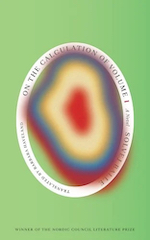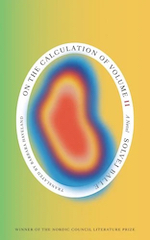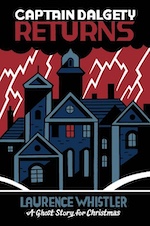 I arrogantly recommend… is a monthly column of unusual, overlooked, ephemeral, small press, comics, and books in translation reviews by our friend, bibliophile, and retired ceiling tile inspector Tom Bowden, who tells us, “This platform allows me to exponentially increase the number of people reached who have no use for such things.”
I arrogantly recommend… is a monthly column of unusual, overlooked, ephemeral, small press, comics, and books in translation reviews by our friend, bibliophile, and retired ceiling tile inspector Tom Bowden, who tells us, “This platform allows me to exponentially increase the number of people reached who have no use for such things.”
Links are provided to our Bookshop.org affiliate page, our Backroom gallery page, or the book’s publisher. Bookshop.org is an alternative to Amazon that benefits indie bookstores nationwide. If you notice titles unavailable online, please call and we’ll try to help. Read more arrogantly recommended reviews at: i arrogantly recommend…
 Silence: Lectures and Writing
Silence: Lectures and Writing
Derek Beaulieu
Timglaset Editions
Derek Beaulieu’s Silence is an homage to John Cage’s book of the same name. In fact, it is the same book as Cage’s less the words. Only the punctuation remains in place on the pages, scattered among them as they occur when the words were there: commas, periods, semi-colons, colons, parentheses, quotation marks, ellipses, slashes, dashes, and question marks up, down, and across the page like a minimalist painting—small black marks against a monotonous white background, forming visual rhythms that mimic the aural when the words are there. Beaulieu’s Silence is a poem of erasure, existing in a space somewhere between asemic writing (writing that looks like content-filled script but isn’t) and concrete poetry (words typed on the page to mimic the action or thing that is the poem’s topic). Silence is also an homage, a visual document, of both silence and emptiness as the Buddhist concepts embraced by Cage.
The seemingly stochastic distribution of punctuation sometimes looks like reverse images of the nighttime sky, with the black punctuation standing in for shimmering stars and planets. Sometimes it makes you wonder what Cage was talking about at certain points—the clusters of question marks, frequent parenthetical asides or clarification, pages in which punctuation is heaviest on the right side of the page, then the bottom, then some other portion of the page. While Silence looks to be an homage to Cage’s devotion to chance operations, the fact of the punctuation—in service to specific content Cage intended to convey—belies that notion, since the punctuation served to corral the semantic content into units. We are left with the corrals, the ghosts of meaning and intention. (Readers who must know Cage’s intention can always pick up a copy of Cage’s Silences and follow along page by page.)
 On the Calculation of Volume, Books I & II
On the Calculation of Volume, Books I & II
Solvej Balle/Barbara J. Haveland
New Directions
The protagonist of Solvej Balle’s seven-volume series On the Calculation of Volume, Tara Selter, finds herself in an awkward state of being one morning, waking up in a hotel room in Paris, where she arrived the night before from her home in the provinces, where she and her husband run a business devoted to vending rare books. The premise of the series books making up Calculation is this: Tara discovers that she is trapped in a single day—a November 18—that repeats itself. Her goal is to figure out how to become unstuck in time. (New Directions has just published the first two of the seven installments that form the novel.) She comes to Paris to pick up a couple of volumes from a couple who run their own rare book business—and does so—only to find out the next morning—or what at first seems to be the next morning—that a strange thing has happened to her.
 Were this a novel of speculative fiction, the author would probably have the narrator think of worm holes, folds in the universe, or other cosmic phenomena requiring a degree in science or mathematics to puzzle out, but alas, our heroine is a merely humanities scholar with a bent for old books and antiquity, and not nearly so cleaver. Tara spends several days in Paris trying to work out what has happened and what her options are, only to discover that she is distressingly alone. The bookselling couple she met with just yesterday—the initial November 18—have no recollection of her visiting their store, buying their books, picking up an old Roman coin, or burning her hand on a portable heater as the three of them sipped tea at the couple’s new apartment. And that last point is the first of many curious inconsistencies Tara notes about her ever-recycling November 18: It has flaws. The burn on her hand from the initial November 18 is still there, even though the events leading to it are not repeated. It fades away, just as burns usually do, over the course of many 24-hour cycles. Too, some purchases she made on that initial November 18 (and those that follow) remain with her while others disappear because she hadn’t yet purchased them.
Were this a novel of speculative fiction, the author would probably have the narrator think of worm holes, folds in the universe, or other cosmic phenomena requiring a degree in science or mathematics to puzzle out, but alas, our heroine is a merely humanities scholar with a bent for old books and antiquity, and not nearly so cleaver. Tara spends several days in Paris trying to work out what has happened and what her options are, only to discover that she is distressingly alone. The bookselling couple she met with just yesterday—the initial November 18—have no recollection of her visiting their store, buying their books, picking up an old Roman coin, or burning her hand on a portable heater as the three of them sipped tea at the couple’s new apartment. And that last point is the first of many curious inconsistencies Tara notes about her ever-recycling November 18: It has flaws. The burn on her hand from the initial November 18 is still there, even though the events leading to it are not repeated. It fades away, just as burns usually do, over the course of many 24-hour cycles. Too, some purchases she made on that initial November 18 (and those that follow) remain with her while others disappear because she hadn’t yet purchased them.
Understandably frustrated by this turn of events and eventually realizing no matter how often she repeats to the couple over multiple November 18s that they never remember anything the next time she visits them, Tara decides to return home. Her husband, Thomas, is surprised to see her: Didn’t she just leave half a day ago? Wasn’t she supposed to be gone the entire weekend? She tells him what has happened. He wants to believe her because he loves her and nothing else about her behavior looks or sounds, well, nutty. But of course, he never remembers morning from morning what she told him the night before. Morning after morning he wakes surprised to find her in bed and asks what’s happened.
Balle’s descriptions of the disjunction between Tara and Thomas—two clearly in love with each other—are pitiable because the fondness between them never abates; they just aren’t in sync anymore. Tara takes to sleeping in the guest room—the daily cycle between them has become too much, emotionally—and accustoms herself to Thomas’s unchanging routine. Since they all repeat themselves with each recurrence of the day, Tara is acutely aware of every sound inside and outside the house, knows which birds will sing and when, which tree leaves will fall and where.
She eventually moves to an empty home for sale. Its position among neighboring houses allows her to move from room to room, to come and go without being seen or heard. Having found out that their bank account renews itself every start of November 18, she can buy groceries every day, and she purchases a telescope for surveying the night sky. Her sense of self and place changes over time, her moods change from relative contentment to certainty that she is a kind of monster. Eventually, she develops a plan to re-synchronize her time with Thomas’s: If she can convince him to return to Paris with her on the 18th, his presence with her may force time to readjust. When she approaches him with her idea, she can tell that he thinks she’s nuts and is frightened by her behavior.
Returning alone to Paris, Tara hopes to find a chink in the cycle that will allow her to re-enter the continuum of time along with everyone else. She tries varying the steps of her day, avoids the shops she went to and the people she spoke with, or arrives at them at a different time of day—anything that might disrupt this hiccup in time she finds herself in. The anniversary of the initial November 18 does not open a door that allows her to rejoin the rest of the world. Book I ends with her lying in her hotel bed, wondering what to do next.
In Book II, to pass the days, Tara wanders the streets by her hotel in larger and larger circles. At first, she begins following crowds wherever they take her—a metro line, a local bus. Eventually, she takes trains to different towns, eavesdrops on conversations and writes them down, and withdraws from her bank each day as much money as she can. She has liberty but no one to talk to about what is most important to her. Although she amasses notes written about her repeated days—well over a year’s worth of November 18s—but who will ever read them? Wouldn’t they disappear when if she died while stuck in time?
On the Calculation of Volume strikes me as a pandemic, describing a time, a moment, frozen in place, an eternal repetition of the same. At least Tara can change locales, but she remains essentially alone, isolated. Tiring of the dreary weather that accompanies late fall, and missing the change of seasons, she realizes that although she may be struck in a day, she is not stuck in a season. And thus she re-creates the seasons by visiting places throughout Europe experiencing temperatures on November 18 that accord with the seasons she feels she should be in—so, northern Europe for winter, southern Europe for spring and summer.
Tara is forced into an eternal moment—well, I suppose we all live in an eternal moment but prefer to focus on the novelties that come with change—a moment she documents in both the diary we read, the novel, and the notebook of “seasons” she keeps to herself, a book listing places she visits and lives in, where the keys to the various apartments she stays in are kept, the foods she makes or orders, descriptions of weather, plants, and forms of clothing she observes others wearing that accord with the changing seasons she is trying to re-create, but minus her emotions.
She remains surprisingly disciplined—avoids slipping into slovenliness in dress and habit, stays sober, clear, and trim, gets haircuts regularly. She retains her dignity and self-respect. Even after her book of seasons and 1,000 Euros are stolen. . . A second year passes, then a third.
Book II ends—manipulatively, in the tradition of cliff-hangers—with Tara’s diary entry suggesting she’s about to meet up with a man she’s found (without telling us beforehand) who also is stuck in a perpetual November 18. On the Calculation of Volume is a remarkable work of imagination, a daunting puzzle matched to an undaunted protagonist, whose resourcefulness and clarity of mind compels readers to want more.
 Ninja Sarutobi Sasuke
Ninja Sarutobi Sasuke
Sugiura Shigeru/Ryan Holmberg
NYR Comics
Ninja Sarutobi finds trouble wherever he goes, officials from his enemy, Tokugawa, after him for stealing their battle plans. From page to page over the course of this book depicting Sarutobi’s adventures, the cartoon style varies from highly stylized and simplified manga to realistic depictions (in the manner of The Classics Illustrated series) of dinosaurs and the American Old West, as seen in Hollywood films from the ‘50s and ‘60s. These changes in styles follow in accord with Sarutobi’s Ninja skills, which allow him to turn invisible, change shape, and change the historical time and location he and his adversaries are in. The slapstick action consists mainly of fight scenes drawn as gags, its violence along the lines of that found in, say, old Bugs Bunny cartoons and the principles of physics as they play out in such worlds.
Episodic, picaresque adventures involving magical transformations into different creatures of varying sizes and time zones—usually the Wild West. Although Ninja Sarutobi Sasuke eventually makes his way back to his dojo and friends, the manga’s last page shows that the fighting never stops. Fortunately, Sarutobi’s good spirits are never foiled, for his ninja magic is supreme.
Ryan Holmberg, Ninja’s translator and all-around manga expert, provides an essay that places Sugiura’s work in the larger context of popular Japanese entertainment of the time, which commonly embedded or quoted Western pop-culture influences, usually Hollywood action films. The original version of Ninja Sarutobi was created in the 1950s. In the late ‘60s, Sugiura was asked to re-draw the original, which Sugiura did, adding new material along the way. The sudden changes in place, time, and drawing style the occur throughout the book result from the magic powers ninjas have—a trait not boasted of by ninjas during the period they wielded power, but that accrued to them over the centuries as they transformed from historical fact to legend and myth, much as have stories in the U.S. surrounding the lives of Paul Bunyan and Pecos Bill.
It’s easy to see why the re-introduction of Ninja Sarutobi Sasuke in the late ‘60s proved so popular and durable, especially for a youth exploring psychedelic experiences, forty years after the birth of Dada and surrealism, the use of icons from pop culture á la Burroughs and Warhol to pit old myths against the new, the sudden switches in visual registers like changing channels on a television. One imagines that if Ninja Sarutobi Sasuke came with a soundtrack, it would be one by Carl Stalling from his days scoring Warner Bros. cartoons. A keystone work in the history of world cartoons.
 Houston, I’m the Problem
Houston, I’m the Problem
Óscar García Sierra / Carmen Yus Quintero
World Poetry Books
Óscar García Sierra is a young poet (b. 1994) from Spain, whose first book Houston, I’m the Problem is, with fluid directness, translated by Carmen Yus Quintero. Written in blank verse, García Sierra’s lines sing of drugs (prescribed and recreational), self-deprecation, depression, and disappointment, of the inability to connect with others—others who might love but find better things to do with their time debased by materialism in a market economy. From the title poem:
if regret were a superpower there would be already several movies about me.
if you like my drunk texts you’ll love my epitaph.
my body worship is based on finding original ways of deforming it.
And this, from “Kinder Triste (Cries in Spanish)”:
i’m going to get out of bed
and i’ll try to disappoint as many people as possible.
i hope they at least name the dead-end street
where they find my body after me.
before i die i want to disappoint every person in the world
at least once.
García Sierra’s poems feel like collages of one-liners: “my voice is quivering when i say: i see the future in your eyes when you’re not looking at me,” “with tiny lies you can induce huge changes in people’s mood,” “and you say: i’m not ready for our phone chargers to touch,” and so forth. They are a young person’s poems (he was 22 when this book was published): nervous, feeling unworthy of hope, disconnected from and misunderstood by others.
A steady diet of anti-depressants; disconnection from society, family, and friends; long-term employment that doesn’t seem possible; self-doubt and self-destructive tendencies the only true and knowable, defining qualities one can authoritatively assert about oneself. While self-deprecation rides a line—the other side of which is a self-abasement resulting in cringeworthy pronouncements about worthlessness—García Sierra avoids that level of abasement, but one book of poetry devoted to self-loathing is enough, beyond which lies dull repetition. The descriptions of his novel Facendera I’ve read indicate a willingness to endow his characters in seemingly hopeless situations with a sense of dignity, despite the odds, a point he hadn’t yet reached with Houston.
 Kommix
Kommix
Charles Burns
Fantagraphics
Charles Burns’ stories and artwork seamlessly unite horror, surrealism, and disquieting absurdism, depicted in the style of dead-pan realism of true story / romance comic books, relying on strong contrasts between light and dark. His graphic novel Black Hole depicted teenage awkwardness as a form of disfiguring disease (Mary Shelley’s Frankenstein can also be read in much the same way.) Throughout his collected works, one finds instances of normal people (usually teenagers) encountering mysterious aliens, worlds in which grotesque meets pathetic, mutation can provide beguiling romantic benefits, and nothing is what it seems. In Kommix, Burns creates a series of covers for magazines that do not exist, including their titles, many for publications suggesting origins in Asia depicting ambiguous images that suggest the answer must lie within the pages of the magazine, but sometimes it’s hard to imagine any context in which the story behind the image would make sense. Magazine titles in English suggest a teen audience: Diary Secrets, Throbbing Heart, Huss, and Teen-Age Romances (and their doppelgangers: Unwholesome Love, Vagina Beauty, Sex Decoy). Highly recommended but for adults only.
 Fragments of a Paradise
Fragments of a Paradise
Jean Giono
Archipelago Books
“Why not try to discover things that are real in the rest of the world? This is what’s left for us to do, I believe, before we surrender to despair.” —The ship’s captain
Perhaps the best novel by Jean Giono I’ve read to date, different in subject from his other works, tales of peasants in rural France, all very good. Fragments of a Paradise, though, is about the sea and sailing, heavily and obviously influenced by Herman Melville. It is also strongly attentive to the senses, tactile and aural—the wooden creaking of the ship, the flap of canvas sails giving voice to the wind, and human voices that carry miles from land to sea—sensations catalogued with intelligence and an awareness that all at sea is important. At sea, a person is inescapably confronted at all moments, days, and months by a non-stop barrage of facts—swells, storms, sharks, and smells (stretches of ocean have their own odors, sometimes, to a nauseating extreme)—and unfathomable mysteries. The crewmen seem more comfortable living under such conditions than they do the with routine certainties of land work. A crewman named Paumolle is subject to two pages cataloging his tattoos, culminating with this image: “Paumolle’s neck itself is decorated all the way around with a line of pea-sized dots accompanied by the inscription: “Tear along dotted line.” The novel’s mysteries— ranging from utter beauty to stark horror—expresses a fate dispassionate and indifferent to their mortal concerns or prayers.
The novel is narrated by the ship’s doctor, who remains nameless. The five-year mission he oversees is described in deliberately evasive terms, probably because it was commissioned by the military to map the coasts of isolated islands between the wars. Because the goal, the purpose, remains vague, a topic that cannot be discussed, the narration focuses on what can be discussed—experience—which turns out to also be that which cannot be articulated. Or, as Wittgenstein might have put it, “What we cannot speak about we must pass over in silence.”
The ship’s doctor describes physical encounters seen, felt, and heard by the crew, but that defy explanation; their significance remain as matters to mull over, as one mulls over the trajectory of one’s own life, trying to make sense of its arc and—perhaps not its legacy, which cannot be predicted—how that arc and those experiences mesh with understanding one’s self in the world, the place of the small within the great.
The captain finds evidence, on the corpse of a dead, young sperm whale, of a squid over 300 meters long, as deduced from sucker scars on the whale’s body. None of the crew, let alone the captain, has ever seen such a monster, although the phosphorescent flashes they see in the middle of the night from what must be several hundred meters down and dispersing, like lightning, several kilometers outward, provide circumstantial evidence of such possibilities before their encounter with the dead whale’s corpse.
The men come to an island once inhabited by a hundred or so sailors, now abandoned, although with evidence suggesting recent habitation, including the possibility of a woman, too. Beautiful imagery thickly populates this novel and crew’s exploration of this island, in particular. The sailor Guinard is asked to inspect the top of the cliffs that surround the island, making it almost impenetrable to anchor nearby, except for a small cove and beach, strewn along which are the ramshackle cabins the former inhabitants lived in. The steep cliffs offer a few narrow chasms that Guinard shimmies up, taking several breaks along his 1,500-meter ascent. The top is a flat mesa, cleaned by breezes of even dust. He slowly inspects the entire mesa, staying through the night to enjoy its silence and solitude:
The stars closed around him meticulously, surrounding him in an unbroken sphere. The silence was so perfect that, a short time later, he even began to hear them crackling. This started in his eyes with some throbbing, or some sharply pointed shafts, which made the constellations pulse rapidly all together, as if a wind out of the depths had slowly stirred their distant embers. Then, in the total silence, which filled his ears like the finest flour, he started to hear the crackling of distant fires. The biggest stars made muffled, creaking sounds and sometimes emitted a short, crystalline cry in concert with the gold and blue flames they were shooting out. The multitudes of luminous particles scattering in all directions through the night sky were making a hushed sound like the chafing of falling snow. At times, even from these muffled depths, a rustling rose up and grew. It came from a long, golden spray that spanned the sky from north to south in a slow procession of flames. Into its wake, the night sky, reunited again, rained down new stars While the revolving night was driving its flocks of stars to the zenith and then herding them down to the sea, the song rumbling on one side of the horizon was growing louder with the sonorities of newly risen stars.
The stunning, rapturous beauty of this novel is conveyed in all its lambent grace and ambiguity by Paul Eprile, one of Giono’s best translators.
 The Amethyst Cross by Mary Fitt; Podolo by L. P. Hartley; Captain Dalgety Returns by Laurence Whistler
The Amethyst Cross by Mary Fitt; Podolo by L. P. Hartley; Captain Dalgety Returns by Laurence Whistler
Designed and decorated by Seth
Biblioasis
A spiritual line unspools itself between the two months between Halloween and Christmas, a period of greyer and greyer days, wetter weather, and dull ache tying unholy morbidity to the putative redemption of humanity implied by Christ’s birth. Illustrator Seth returns for the tenth year with a new batch of ghost stories originally written and published for the Christmas season (even though the stories themselves have nothing to do with the holiday), each story printed as a pocket-sized book taking about a half hour to hour to read, focusing on eerie and macabre (but never gory) tales of misadventure with bad spirits.
In this year’s batch, The Amethyst Cross, written by the Greek classicist and mystery writer Kathleen Freeman under her pseudonym Mary Fitt, is a moody piece falling into the subgenre of secular rationalist encounters with the evil dead. The Amethyst Cross is alternately related by a woman named Margaret and her Aunt Dorothea. Dorothea compels her niece to find her a cottage to spend the spring near the British moors where the put-upon Margaret is staying during her scholar’s sabbatical—a cozy, out-of-the-way place that was the site of a gruesome murder and theft 80 years before—and Dorothea narrates the unsettling events leading to her sudden departure, with a surprising denouement ending in Arizona.
 L. P. Hartley’s Podolo takes place in Venice, where a trio of friends row a gondola to a small island in the middle of a canal, setting off to enjoy a few hours of picnicking. The island would appear to be uninhabited, save for a feral cat that one of the friends, Angela, tries to capture to take home. Unsuccessful with her initial attempt, Angela explores the island to track down the cat after the lunch. The other friends—Walter, Mario the gondolier, and the unnamed narrator—wait for her, drowsing in the mid-day heat. When Angela fails to return and they wander the island to find her, something other—something indiscernible except for its evil effect—lets them know that Angela’s fate could be their own if they persist.
L. P. Hartley’s Podolo takes place in Venice, where a trio of friends row a gondola to a small island in the middle of a canal, setting off to enjoy a few hours of picnicking. The island would appear to be uninhabited, save for a feral cat that one of the friends, Angela, tries to capture to take home. Unsuccessful with her initial attempt, Angela explores the island to track down the cat after the lunch. The other friends—Walter, Mario the gondolier, and the unnamed narrator—wait for her, drowsing in the mid-day heat. When Angela fails to return and they wander the island to find her, something other—something indiscernible except for its evil effect—lets them know that Angela’s fate could be their own if they persist.
 Captain Dalgety Returns by Laurence Whistler concerns a grumpy, distraught single father whose wife died while giving birth to their daughter, a daughter he means to do well by but instead finds himself scolding over trifles which he later regrets, a daughter he at first abandoned during his initial period of grief after the girl’s mother died, leaving the girl to be raised by others. His daughter wishes to be close to him but does not know how. He is distant and moody, wishes to be different, and also does not know how to change their relationship—until a walk in the countryside transforms him forever.
Captain Dalgety Returns by Laurence Whistler concerns a grumpy, distraught single father whose wife died while giving birth to their daughter, a daughter he means to do well by but instead finds himself scolding over trifles which he later regrets, a daughter he at first abandoned during his initial period of grief after the girl’s mother died, leaving the girl to be raised by others. His daughter wishes to be close to him but does not know how. He is distant and moody, wishes to be different, and also does not know how to change their relationship—until a walk in the countryside transforms him forever.
